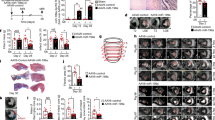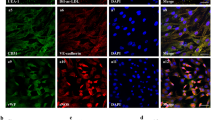Abstract
It has been proposed that thymosin beta 4 (TB4)-protein delivery stimulates differentiation of resident adult WT1-positive cardiac progenitor cells, but with very low efficiency. We determined whether gene therapy with human TB4 stimulates proliferation of resident adult cardiac progenitor cells in normal rat heart. Ultrasound-targeted microbubble destruction (UTMD) was used to deliver the human TB4 gene under a piggybac transposon plasmid to normal rat heart. The rat hearts were assayed by quantitative reverse transcription–PCR and immunohistology with a confocal microscope at 1, 2, 3, 4 and 12 weeks after UTMD. Exogenous TB4 stimulation resulted in the presence of WT1-positive cardiac progenitor cells from epicardium to endocardium. TB4 stimulated angiogenesis and arteriogenesis. One month after TB4 gene therapy by UTMD, the percentage of NKX2.5-positive cardiomyocytes was 5.5±1.0% and NKX2.5 mRNA was 24-fold higher than in the control groups (P<0.001). Similar results were found for ISL-1, BrDu, Ki-67, PHH3 and aurora B (P<0.001). Cardiac-specific delivery of exogenous human TB4 gene efficiently stimulates proliferation and differentiation of resident WT1-positive adult cardiac progenitor cells into three intact cardiac cell lineages—vascular endothelial cells, coronary artery smooth muscle cells and cardiac muscle cells in normal adult rat heart.
This is a preview of subscription content, access via your institution
Access options
Subscribe to this journal
Receive 12 print issues and online access
$259.00 per year
only $21.58 per issue
Buy this article
- Purchase on Springer Link
- Instant access to full article PDF
Prices may be subject to local taxes which are calculated during checkout







Similar content being viewed by others
Change history
07 February 2013
This article has been corrected since online publication and a corrigendum is also printed in this issue
References
Roger VL, Go AS, Lloyd-Jones DM, Benjamin EJ, Berry JD, Borden WB et al. Heart disease and stroke statistics--2012 update: a report from the American Heart Association. Circulation 2012; 125: e2–e220.
van Laake LW, Passier R, Doevendans PA, Mummery CL . Human embryonic stem cell-derived cardiomyocytes and cardiac repair in rodents. Circ Res 2008; 102: 1008–1010.
Martinez-Fernandez A, Nelson TJ, Yamada S, Reyes S, Alekseev AE, Perez-Terzic C et al. iPS programmed without c-MYC yield proficient cardiogenesis for functional heart chimerism. Circ Res 2009; 105: 648–656.
Williams AR, Hare JM . Mesenchymal stem cells: biology, pathophysiology, translational findings, and therapeutic implications for cardiac disease. Circ Res 2011; 109: 923–940.
Bolli R, Chugh AR, D’Amario D, Loughran JH, Stoddard MF, Ikram S et al. Cardiac stem cells in patients with ischaemic cardiomyopathy (SCIPIO): initial results of a randomised phase 1 trial. Lancet 2011; 378: 1847–1857.
Smart N, Riley PR . The epicardium as a candidate for heart regeneration. Future Cardiol 2012; 8: 53–69.
Chong JJ, Chandrakanthan V, Xaymardan M, Asli NS, Li J, Ahmed I et al. Adult cardiac-resident MSC-like stem cells with a proepicardial origin. Cell Stem Cell 2011; 9: 527–540.
Smart N, Bollini S, Dubé KN, Vieira JM, Zhou B, Davidson S et al. De novo cardiomyocytes from within the activated adult heart after injury. Nature 2011; 474: 640–644.
Bollini S, Smart N, Riley PR . Resident cardiac progenitor cells: at the heart of regeneration. J Mol Cell Cardiol 2011; 50: 296–303.
Zaruba MM, Soonpaa M, Reuter S, Field LJ . Cardiomyogenic potential of C-kit(+)-expressing cells derived from neonatal and adult mouse hearts. Circulation 2010; 121: 1992–2000.
Chen S, Shohet RV, Bekeredjian R, Frenkel P, Grayburn PA . Optimization of ultrasound parameters for cardiac gene delivery of adenoviral or plasmid deoxyribonucleic acid by ultrasound-targeted microbubble destruction. J Am Coll Cardiol 2003; 42: 301–308.
Bekeredjian R, Chen S, Frenkel PA, Grayburn PA, Shohet RV . Ultrasound-targeted microbubble destruction can repeatedly direct highly specific plasmid expression to the heart. Circulation 2003; 108: 1022–1026.
Korpanty G, Chen S, Shohet RV, Ding J, Yang B, Frenkel PA et al. Targeting of VEGF-mediated angiogenesis to rat myocardium using ultrasonic destruction of microbubbles. Gene Ther 2005; 12: 1305–1312.
Müller OJ, Schinkel S, Kleinschmidt JA, Katus HA, Bekeredjian R . Augmentation of AAV-mediated cardiac gene transfer after systemic administration in adult rats. Gene Ther 2008; 15: 1558–1565.
Kobulnik J, Kuliszewski MA, Stewart DJ, Lindner JR, Leong-Poi H . Comparison of gene delivery techniques for therapeutic angiogenesis ultrasound-mediated destruction of carrier microbubbles versus direct intramuscular injection. J Am Coll Cardiol 2009; 54: 1735–1742.
Leong-Poi H, Kuliszewski MA, Lekas M, Sibbald M, Teichert-Kuliszewska K, Klibanov AL et al. Therapeutic arteriogenesis by ultrasound-mediated VEGF165 plasmid gene delivery to chronically ischemic skeletal muscle. Circ Res 2007; 101: 295–303.
Chen S, Ding JH, Bekeredjian R, Yang BZ, Shohet RV, Johnston SA et al. Efficient gene delivery to pancreatic islets with ultrasonic microbubble destruction technology. Proc Natl Acad Sci USA 2006; 103: 8469–8474.
Chen S, Shimoda M, Chen J, Matsumodo S, Grayburn PA . Transient overexpression of Cyclin D2/CDK4/GLP1 genes induces proliferation and differentiation of adult pancreatic progenitors and mediates islet regeneration. Cell Cycle 2012; 11: 695–705.
Chen S, Shimoda M, Chen J, Matsumoto S, Grayburn PA . Ectopic transgenic expression of NKX2.2 induces differentiation of adult pancreatic progenitors and mediates islet regeneration. Cell Cycle 2012; 11: 1544–1553.
Saridey SK, Liu L, Doherty JE, Kaja A, Galvan DL, Fletcher BS et al. PiggyBac transposon-based inducible gene expression in vivo after somatic cell gene transfer. Mol Ther 2009; 17: 2115–2120.
Cary LC, Goebel M, Corsaro BG, Wang HG, Rosen E, Fraser MJ . Transposon mutagenesis of baculoviruses: analysis of Trichoplusia ni transposon IFP2 insertions within the FP-locus of nuclear polyhedrosis viruses. Virology 1989; 172: 156–169.
Fraser MJ, Cary L, Boonvisudhi K, Wang HG . Assay for movement of Lepidopteran transposon IFP2 in insect cells using a baculovirus genome as a target DNA. Virology 1995; 211: 397–407.
Cadiñanos J, Bradley A . Generation of an inducible and optimized piggyBac transposon system. Nucleic Acids Res 2007; 35: e87.
Smart N, Risebro CA, Melville AA, Moses K, Schwartz RJ, Chien KR et al. Thymosin beta4 induces adult epicardial progenitor mobilization and neovascularization. Nature 2007; 445: 177–182.
Riley PR, Smart N . Thymosin beta4 induces epicardium-derived neovascularization in the adult heart. Biochem Soc Trans 2009; 37: 1218–1220.
Vieira JM, Riley PR . Epicardium-derived cells: a new source of regenerative capacity. Heart 2011; 97: 15–19.
Zhou B, Honor LB, Ma Q, Oh JH, Lin RZ, Melero-Martin JM et al. Thymosin beta 4 treatment after myocardial infarction does not reprogram epicardial cells into cardiomyocytes. J Mol Cell Cardiol 2012; 52: 43–47.
Meijering BD, Juffermans LJ, van Wamel A, Henning RH, Zuhorn IS, Emmer M et al. Ultrasound and microbubble-targeted delivery of macromolecules is regulated by induction of endocytosis and pore formation. Circ Res 2009; 104: 679–687.
Zhou B, Ma Q, Rajagopal S, Wu SM, Domian I, Rivera-Feliciano J et al. Epicardial progenitors contribute to the cardiomyocyte lineage in the developing heart. Nature 2008; 454: 109–113.
Song K, Nam YJ, Luo X, Qi X, Tan W, Huang GN et al. Heart repair by reprogramming non-myocytes with cardiac transcription factors. Nature 2012; 485: 599–604.
Jopling C, Sleep E, Raya M, Martí M, Raya A, Izpisúa Belmonte JC . Zebrafish heart regeneration occurs by cardiomyocyte dedifferentiation and proliferation. Nature 2010; 464: 606–609.
Porrello ER, Mahmoud AI, Simpson E, Hill JA, Richardson JA, Olson EN et al. Transient regenerative potential of the neonatal mouse heart. Science 2011; 331: 1078–1080.
Author information
Authors and Affiliations
Corresponding author
Ethics declarations
Competing interests
The authors declare no conflict of interest.
Additional information
Supplementary Information accompanies the paper on Gene Therapy website
Supplementary information
Rights and permissions
About this article
Cite this article
Chen, S., Shimoda, M., Chen, J. et al. Stimulation of adult resident cardiac progenitor cells by durable myocardial expression of thymosin beta 4 with ultrasound-targeted microbubble delivery. Gene Ther 20, 225–233 (2013). https://doi.org/10.1038/gt.2012.89
Received:
Revised:
Accepted:
Published:
Issue Date:
DOI: https://doi.org/10.1038/gt.2012.89
Keywords
This article is cited by
-
Epicardial slices: an innovative 3D organotypic model to study epicardial cell physiology and activation
npj Regenerative Medicine (2022)
-
Fundamentals of Cardiovascular Molecular Imaging: a Review of Concepts and Strategies
Current Cardiovascular Imaging Reports (2017)
-
Gene therapy for cardiovascular disease mediated by ultrasound and microbubbles
Cardiovascular Ultrasound (2013)
-
Contrast Echocardiography: Current Applications and Future Perspectives
Current Cardiovascular Imaging Reports (2013)



